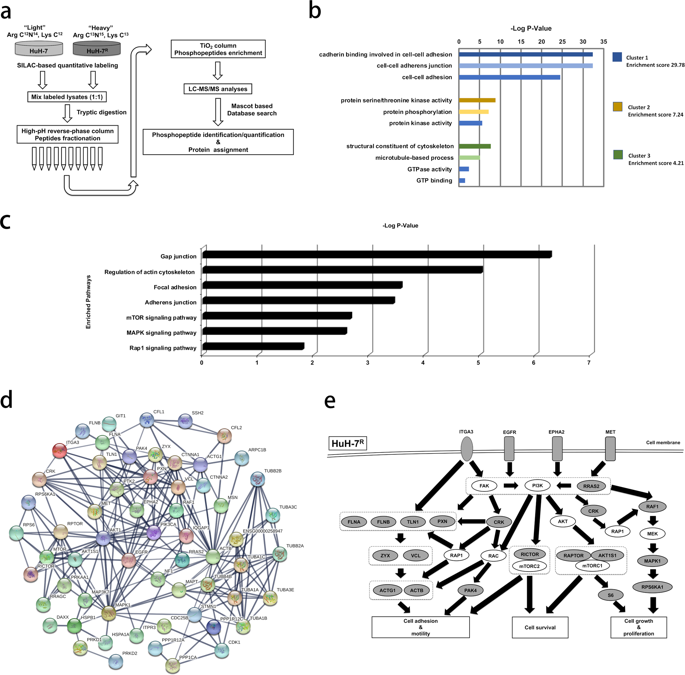当前位置:
X-MOL 学术
›
Exp. Mol. Med.
›
论文详情
Our official English website, www.x-mol.net, welcomes your
feedback! (Note: you will need to create a separate account there.)
Quantitative phosphoproteomic analysis identifies the potential therapeutic target EphA2 for overcoming sorafenib resistance in hepatocellular carcinoma cells.
Experimental & Molecular Medicine ( IF 9.5 ) Pub Date : 2020-03-19 , DOI: 10.1038/s12276-020-0404-2 Chih-Ta Chen,Li-Zhu Liao,Ching-Hui Lu,Yung-Hsuan Huang,Yu-Kie Lin,Jung-Hsin Lin,Lu-Ping Chow
Experimental & Molecular Medicine ( IF 9.5 ) Pub Date : 2020-03-19 , DOI: 10.1038/s12276-020-0404-2 Chih-Ta Chen,Li-Zhu Liao,Ching-Hui Lu,Yung-Hsuan Huang,Yu-Kie Lin,Jung-Hsin Lin,Lu-Ping Chow

|
Limited therapeutic options are available for advanced-stage hepatocellular carcinoma owing to its poor diagnosis. Drug resistance to sorafenib, the only available targeted agent, is commonly reported. The comprehensive elucidation of the mechanisms underlying sorafenib resistance may thus aid in the development of more efficacious therapeutic agents. To clarify the signaling changes contributing to resistance, we applied quantitative phosphoproteomics to analyze the differential phosphorylation changes between parental and sorafenib-resistant HuH-7 cells. Consequently, an average of ~1500 differential phosphoproteins were identified and quantified, among which 533 were significantly upregulated in resistant cells. Further bioinformatic integration via functional categorization annotation, pathway enrichment and interaction linkage analysis led to the discovery of alterations in pathways associated with cell adhesion and motility, cell survival and cell growth and the identification of a novel target, EphA2, in resistant HuH-7R cells. In vitro functional analysis indicated that the suppression of EphA2 function impairs cell proliferation and motility and, most importantly, overcomes sorafenib resistance. The attenuation of sorafenib resistance may be achieved prior to its development through the modulation of EphA2 and the subsequent inhibition of Akt activity. Binding analyses and in silico modeling revealed a ligand mimic lead compound, prazosin, that could abate the ligand-independent oncogenic activity of EphA2. Finally, data obtained from in vivo animal models verified that the simultaneous inhibition of EphA2 with sorafenib treatment can effectively overcome sorafenib resistance and extend the projected survival of resistant tumor-bearing mice. Thus our findings regarding the targeting of EphA2 may provide an effective approach for overcoming sorafenib resistance and may contribute to the management of advanced hepatocellular carcinoma.
中文翻译:

磷酸化蛋白质组学定量分析确定了克服肝细胞癌细胞索拉非尼耐药性的潜在治疗靶标EphA2。
由于诊断不良,晚期肝细胞癌的治疗选择有限。索拉非尼是唯一可用的靶向药物,目前普遍报道其耐药性。因此,对索拉非尼耐药性潜在机制的全面阐明可能有助于开发更有效的治疗剂。为了阐明导致耐药的信号传导变化,我们应用了定量磷酸化蛋白质组学技术来分析亲本和索拉非尼耐药的HuH-7细胞之间的差异磷酸化变化。因此,平均鉴定出约1500种差异化磷蛋白并进行了定量,其中533种在抗性细胞中显着上调。通过功能分类注释进行进一步的生物信息集成,途径富集和相互作用连锁分析导致发现了与细胞粘附和运动,细胞存活和细胞生长相关的途径改变,并鉴定了抗性HuH-7R细胞中的新靶标EphA2。体外功能分析表明,抑制EphA2功能会损害细胞增殖和运动能力,最重要的是,它会克服索拉非尼的耐药性。索拉非尼耐药性的减弱可在其发展之前通过调节EphA2和随后抑制Akt活性来实现。结合分析和计算机模拟显示,配体模拟先导化合物prazosin可减轻EphA2不依赖配体的致癌活性。最后,从体内动物模型获得的数据证实,索拉非尼治疗同时抑制EphA2可以有效克服索拉非尼耐药性并延长具有耐药性的荷瘤小鼠的预计生存期。因此,我们关于靶向EphA2的发现可能为克服索拉非尼耐药性提供了有效的方法,并且可能有助于晚期肝细胞癌的治疗。
更新日期:2020-04-24
中文翻译:

磷酸化蛋白质组学定量分析确定了克服肝细胞癌细胞索拉非尼耐药性的潜在治疗靶标EphA2。
由于诊断不良,晚期肝细胞癌的治疗选择有限。索拉非尼是唯一可用的靶向药物,目前普遍报道其耐药性。因此,对索拉非尼耐药性潜在机制的全面阐明可能有助于开发更有效的治疗剂。为了阐明导致耐药的信号传导变化,我们应用了定量磷酸化蛋白质组学技术来分析亲本和索拉非尼耐药的HuH-7细胞之间的差异磷酸化变化。因此,平均鉴定出约1500种差异化磷蛋白并进行了定量,其中533种在抗性细胞中显着上调。通过功能分类注释进行进一步的生物信息集成,途径富集和相互作用连锁分析导致发现了与细胞粘附和运动,细胞存活和细胞生长相关的途径改变,并鉴定了抗性HuH-7R细胞中的新靶标EphA2。体外功能分析表明,抑制EphA2功能会损害细胞增殖和运动能力,最重要的是,它会克服索拉非尼的耐药性。索拉非尼耐药性的减弱可在其发展之前通过调节EphA2和随后抑制Akt活性来实现。结合分析和计算机模拟显示,配体模拟先导化合物prazosin可减轻EphA2不依赖配体的致癌活性。最后,从体内动物模型获得的数据证实,索拉非尼治疗同时抑制EphA2可以有效克服索拉非尼耐药性并延长具有耐药性的荷瘤小鼠的预计生存期。因此,我们关于靶向EphA2的发现可能为克服索拉非尼耐药性提供了有效的方法,并且可能有助于晚期肝细胞癌的治疗。











































 京公网安备 11010802027423号
京公网安备 11010802027423号